Black Swamp Savior: How Bringing Back Conquered Wetlands Could Help Solve Harmful Algal Blooms
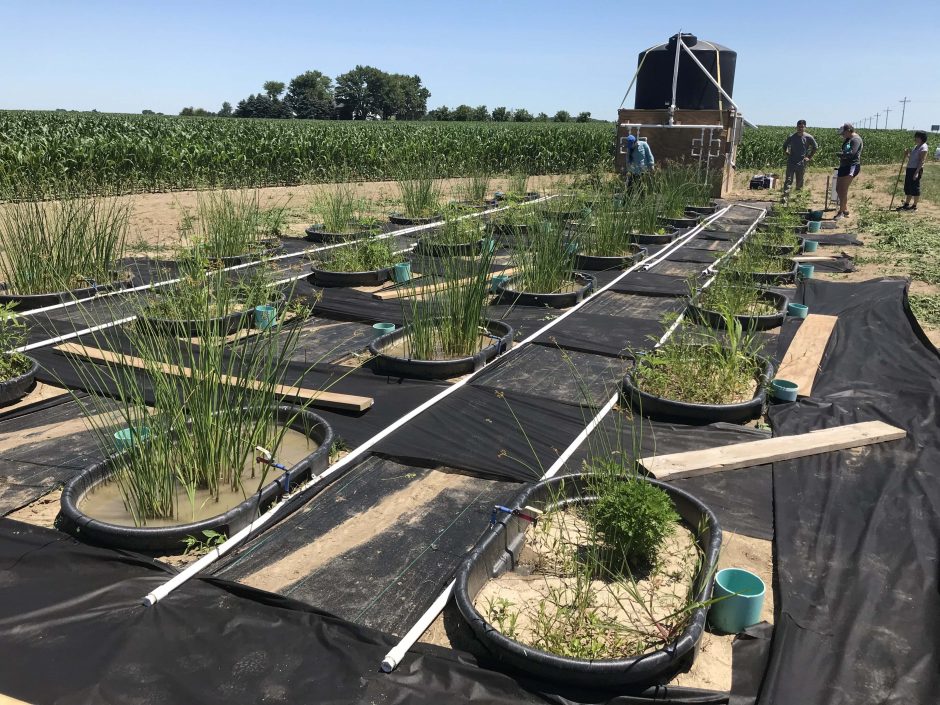
Defiance Mesocosm setup at Lenhart Farm. (Credit: Bill Mitsch)
Once submerging about 1,500 square miles of northwest Ohio, the Black Swamp was viewed as an enormous nuisance that made settling the region difficult for hundreds of new arrivals seeking new lands to build homes and raise families. After about 40 years of extremely hard labor and a few key technological advancements such as drainage tiles, the Black Swamp was emptied and its wetlands destroyed. Underneath the swamp waters lay some of the most nutrient-rich and productive farmland in the world. The families, who now had plenty of room to raise houses, fence off pastures and grow crops became fruitful and multiplied, establishing the Lake Erie region as an agricultural powerhouse for almost the next two hundred years.
All the farming success, however, had a cost. Fertilizer components such as nitrogen and phosphorus, while making high-quality, productive soil even more productive, also ran off into surrounding waterways. Nutrient levels became too high in the waters, causing Harmful Algal Blooms (HAB) that depleted oxygen and contaminated drinking water, killing fish and rendering water undrinkable for surrounding farms and towns. As climate change increases average water temperatures around the globe, HABs are becoming more frequent and more intense in Lake Erie, especially since 2011, as elevated temperatures only encourage algal growth. The Lake Erie HAB of 2014 rendered Toledo residents’ water undrinkable for days. While HABs wax and wane with the seasons, the overall trend each year is in the direction of worse HAB effects. A simple solution, however, seems elusive: on the one hand, farmers use nitrogen and phosphorus-laden additives to boost farm productivity. On the other hand, nitrogen and phosphorus are also the reason behind HABs, which can poison the water supply. Farmers depend on the productivity of their land to produce the crops thousands of people rely on. However, these are some of the same forces that cause HAB and contaminate the waters. Any solution must maintain farm productivity, while also preventing—or mitigating—HABs. But does such a solution exist?
World-renowned wetland ecologist Bill Mitsch, Eminent Scholar and Director of Everglades Wetland Research Park, College of Art & Sciences, and Sproul Chair for Southwest Florida Habitat Restoration at Florida Gulf Coast University, believes there is. And he believes the reviled Black Swamp, a source of so many obstacles for the region’s original settlers, may show the way towards maintaining farm productivity and tackling HAB.
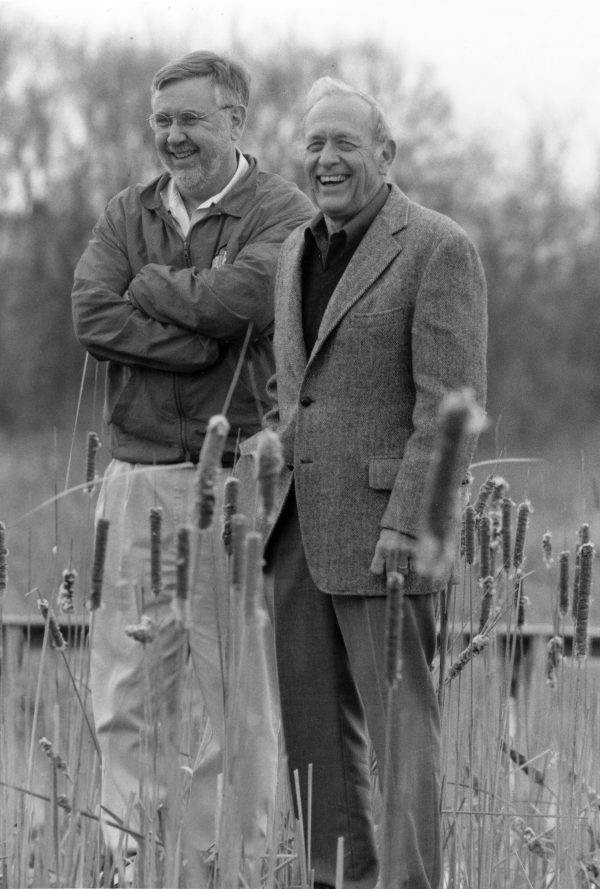
Bill Mitsch and Jim Gosselink, authors of Wetlands textbook (first edition 1986; latest edition is 2015) photo in 1999 personal collection of WJM. (Credit: with permission)
“Basically, you have to use the land itself as the solution. Nothing else is really effective or practical,” says Mitsch. “Wetlands are fantastic at removing excess nutrients and contaminants from waterways. If the Black Swamp area wetlands were partly restored, we would go a long way towards correcting the HAB problems we are seeing more and more of today. But we need wetlands that are compatible with still maintaining productivity of the Lake Erie area’s farms.”
The Lake Erie region isn’t the only region that could benefit from the approach of resurrecting wetlands long supplanted by agriculture and development. “There are parallels in Lake Taihu in China, in the Florida Everglades, in Toronto and other places all over the globe. My colleagues and I have set up mesocosms in several geographical locations to prove that this idea could work and that we could scale it up to solve real HAB problems that the Lake Erie region and other areas are confronting right now, and will continue to confront in the future,” Mitsch explains.
Mitsch’s mesocosms are essentially set up in the same way at each of his three sites. There are sites in Defiance County, Buckeye Lake and Naples. The first two sites are in Ohio and the third is in Florida.
At each site, there are 28, plastic, 100-gallon, Rubbermaid TM, tubs each of which represents a physical model of a wetland. There are four conditions, with seven replicates for each condition. Seven replicates are high water (standing water above the soil) with high flow rate, and seven are high water with low flow rate, seven are low water (moist soil but no standing water) with high flow rate and seven are low water with low flow rate. Water is fed, by gravity, into and drained out of, the mesocosms every week. Each mesocosm is one square meter in size, thus making calculations easy. The Defiance site is unique, however, in that it has an in-flow control system that allows Mitsch, his students and staff to control water flow remotely. The in-flow control system was designed by Fondriest Environmental. The system can be controlled via laptop or phone.
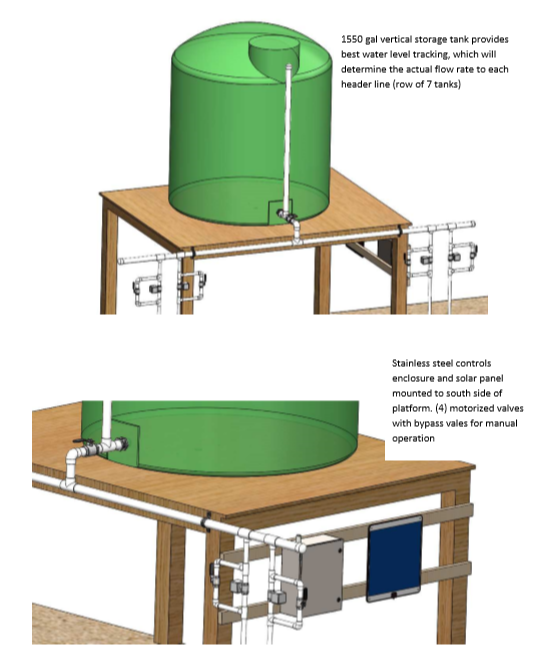
Defiance, Ohio mesocosm diagram (Credit: Steve Fondriest)
“Having our remote system in Defiance has been tremendously helpful,” says Mitsch. “The site is far away from many of our other activities, so not having to make the three-hour drive from Columbus required to reach the site is a huge time saver.”
The Defiance tubs have been equipped with devices that allow data to be uploaded and valves to be controlled remotely. Water is fed into the tubs from a 1,500-gallon tank via gravity. The input of water into the mesocosm and output of water are both measured. “We can put in a designated amount of water per week,” says Mitsch.
Although the Defiance site water flow is controlled remotely, water quality sampling is still performed manually. Mitsch’s water quality samples are then sent to his lab in Naples, Florida. Water quality samples are taken every other week.
Water hydrology is measured as well as the nature of the flow.
Nutrients measurements include total nitrogen and phosphorus. Both total and reactive phosphorus are measured as well as total nitrogen and nitrate. “These are potentially tied to the HAB,” says Mitsch.
The nutrient samples are packed in ice and are sent express mail to the Mitsch’s south Florida lab in Naples, where they are analyzed by a British-made SmartCam autoanalyzer system. All of Mitsch’s sites use the same lab.
“Interestingly, we have found that the low water versions of the mesocosms are taking up more phosphorus than the deep water ones, at least at Buckeye Lake,” Mitsch adds.
Two loading rigs are used for mesocosm system water flow. The low flow version is 10 cm per week, and the high flow rate is 30 cm per week. For comparison, precipitation (rain and snow) contribute an average of about 2 cm per week at the Ohio sites and slightly more in Florida.
The two water depths are independent, and they are determined by the height of the outflow standpipes next to the tubs, with the longer pipes (20 inches) giving their mesocosms standing water, and the shorter pipes (16 inches) giving their mesocosms no standing water, just moist soil. PVC elbows are under the tubs, and the pipes are attached to the elbows. Larger diameter pipes surround white standpipes, protecting them and allowing easy removal of the standpipes to change the water levels if needed.
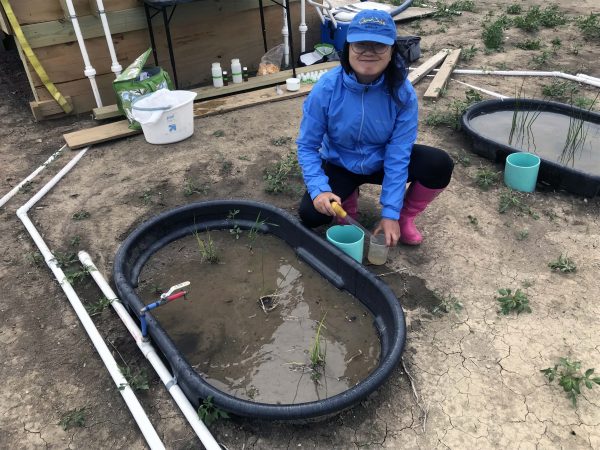
University of South Florida and Bill Mitsch’s Ph.D. student BingBing Jiang taking water quality samples at Defiance Ohio wetlaculture experiment, May 2018. (Credit: Bill Mitsch)
The two conditions of either standing water or no standing water lead to distinct differences in the mesocosms. “The standing water ones lead to aerobic conditions, the ones without standing water are mostly anaerobic,” Mitsch explains. “Also, the standing water ones will choke out non-wetland plant species, while favoring wetland vegetation. Soft-stem bulrushes thrive in standing water conditions, but most other plants don’t. If you look at the tubs with no standing water and just moist soil, you can readily see more grass species and other plants growing in there.”
Soil used in the mesocosms is simply whatever soil is found naturally at the site. Plants used are wetland grasses or sedges similar to what might naturally be found at the site, but there is some flexibility. “We found that the types of plants we used were not very critical, so long as they were wetland plants,” said Mitsch. Mitsch prefers to get his plants from Cardno (formerly J.F. New) near South Bend, Indiana. “They have high-quality native plants, lots of varieties,” he mentions.
Soft-stem bulrush was planted in October 2017 in mesocosms in the Defiance site and continues to dominate in the deepwater mesocosms. The mesocosms with moist soil now have many other varieties of plants surviving, some not wetland plants, which is clear even with a cursory visual inspection. The same plants are used in the Buckeye Lake mesocosms. “In our Florida site, however, we used sawgrass, since that’s native there,” Mitsch adds, “and common throughout the Everglades.”
The water Mitsch uses in his mesocosm setups is from nearby ditches or rivers discharge areas that normally receive nutrient-laden runoff. Every week, water is added to the system by pumps and then to the mesocosms by gravity.
“Starting around February and through May or June, the ditches are filled with water,” says Mitsch. “They’re full of phosphorus and algae flowing to the Maumee River and on to Lake Erie! It’s the same algae and nutrients that are trashing Lake Erie.”
But Mitsch may change all that if his mesocosms are scaled up in the future and put to work in the former Black Swamp region.
“Early results from our mesocosms in Defiance have been shown to remove 80 percent of the total phosphorus in the water, which is pretty impressive,” Mitsch points out. “The phosphorus is absorbed by both wetland plants and the soil. It is an ecosystem effect, not simply due to the plants or soil by themselves.”
Even so, taking productive land out of commission to reintroduce wetlands that produce no commercial crops has been a tough sell for area farmers. While they want to address the HAB problem, they don’t want to produce less food and make less profit.
“What we want people to realize is, we’re not suggesting that land be permanently taken out of commission to make wetlands. For our mesocosms, if you take the standpipe out, the mesocosm will go back to being dry farmland again. We’re advocating flipping the land. Have a wetland area, then after three years flip it back to dry land. Farmers will also save money since they won’t need to fertilize their fields in that case, since the wetlands have already pulled up all the phosphorus out of the ditches and other runoff water. That phosphorus is then available to crops after the land has been dried out and put back to use as farmland,” Mitsch explains.
How much land would be needed to stem the eutrophication tide in Lake Erie caused by all the excess nitrogen and phosphorus from farm runoff?
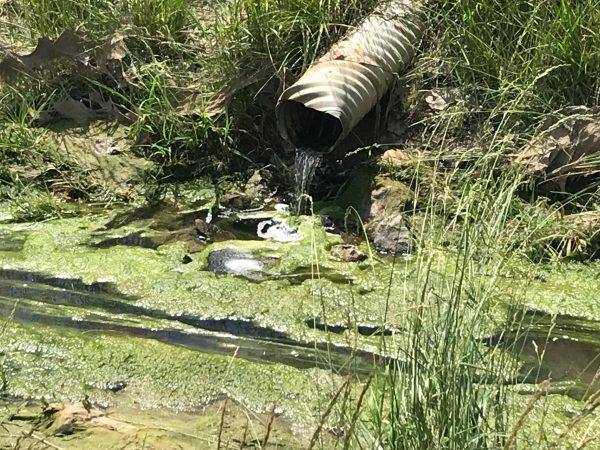
Drainage pipe draining farmland in former Black Swamp region into drainage ditch, mid June 2018. These algal growths well into early summer led me to predict that the Lake Erie HAB will be bad in 2018. (Credit: Bill Mitsch)
“We may need 100,000 acres,” says Mitsch. “But it would all go in and out of rotation as farmland. In its wetland phase, the tile system can be corked up to create wetlands, and the cork pulled out if you want farmland instead.”
Mitsch suggests farmers could get paid for conservation easements if they create wetlands. There could also be water quality trading or nitrogen trading credits. Also, farmers could get financial credit for taking phosphorus out of the environment.
“Wetlands are also the best ecosystem for removing CO2 from the environment,” says Mitsch. “Farmers could get carbon credit for removing carbon from the atmosphere as well. They could buy or sell carbon credits. So farmers could get credit for saving fertilizer, get conservation credits, water quality credits and carbon credits.”
Mitsch isn’t the only one who thinks that “wetlaculture” or “wetlands agriculture” could potentially be a boon for farmers, not a threat. Ohio State University and University of Notre Dame professors are helping to create an economic and business model for the enterprise. Also, some property and farm owners support the wetlands restoration idea, such as the Lenhart family, who allowed Mitsch to build his mesocosms on their land in Defiance.
And then there is the Barley Prize, a ten-million-dollar prize offered by the Everglades Foundation and co-sponsored by Scotts Miracle-Gro, which would go to the group that manages to solve the problem of recovering all the excess phosphorus in areas such as Lake Erie while also leaving only clean water behind.
“The Prize is why we started the work,” says Mitsch. “It was a huge incentive for we water quality and wetland researchers.”
While Mitsch and his team were chosen as finalists in the early stages of the contest in 2017, recent rules changes have caused setbacks. “Now we are required to move our solution apparatus to Ontario, Canada as part of the testing process. But I’m not sure how we could move our mesocosms. They’re a little too big,” he says. “I think the organizers are envisioning some kind of contraption, a machine that would pick up phosphorus or something, but the scale of this thing is really beyond that. For example, you could remove phosphorus chemically from the water, but you would need truckloads and truckloads of chemicals to do that. It’s just not practical. From our research, only using the land to help clean up the phosphorus would yield a reasonable solution for the scale needed. We’re still hoping to somehow find a way to show the prize judges that.”
Mitsch has other sources of funding, however, and continues to seek support from the National Science Foundation.
“I’ve been intrigued about ‘fixing the planet’ since the very first Earth Day in 1970,” Mitsch reflects. “I had an engineering degree, but I knew nothing about the environment. I decided I was going to learn about it. I’ve been learning ever since.”
Mitsch has spent his academic career at several universities teaching a generation of scientists and engineers how to use wetlands as a tool to clean up their local aquatic ecosystems, whether it is Lake Erie and Buckeye Lake in Ohio, Lake Taihu in China, or Lake Okeechobee in Florida and make their waterways clear again.
Top image: Defiance Mesocosm Setup at Lenhart Farm. (Credit: Bill Mitsch)




0 comments